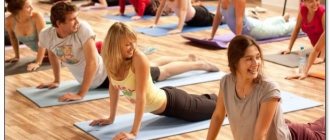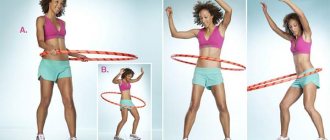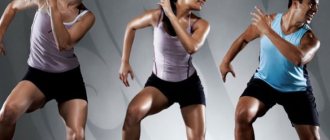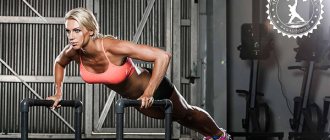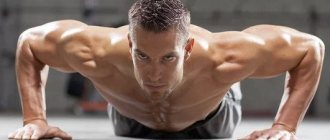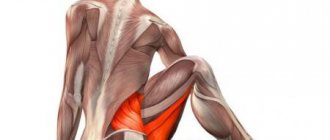A trend called “cycling” is becoming increasingly popular in modern fitness clubs. Cycle is a group lesson that is carried out using exercise bikes. During the lesson, the instructor controls the riding pace and load, and also provides moral support to the students so that they do not get bored while performing monotonous movements. In turn, every reasonable exerciser thinks, when sitting on an exercise bike, what muscles work during training and how intense pedaling affects his body? Today we will look at these questions and put everything in order.
When you sit on an exercise bike, what muscles are working?
Classes on an exercise bike are designed to imitate riding a real bicycle, but there are significant differences. For example, the risk of getting injured while riding an exercise bike is negligible, while fans of real (especially extreme) cycling periodically find themselves in unpleasant situations. In addition, the effect on muscles that exercise on an exercise bike has is different from riding a real bicycle. This is due, first of all, to the fact that the bicycle is unstable and moves relative to space, while the exercise bike is motionless and stands firmly on the floor.
By pedaling an exercise bike, you can change the load, simulating riding uphill and changing gears on a real bike. Also, most exercise bikes are equipped with displays that allow you to see how fast you are riding, what your heart rate is, how many calories you are burning, etc.
How exercise on an exercise bike affects the body
To begin with, it’s worth saying a few words about how exercise on an exercise bike, taken together, affects your physical condition. Riding an exercise bike perfectly trains the cardiovascular and respiratory systems, and also develops the muscles of the lower body - legs and buttocks. In addition, intensive cycling classes will help you lose excess weight and improve your well-being.
Do you know which muscles are most affected by cycling?
Let me remind you here that in order to start burning fat, you need to pedal intensely for at least 20-30 minutes. After this period of time, the body will use up the available carbohydrates and reach its fat reserves. An exercise bike is classified as a cardio simulator, which, however, does not prevent those exercising at a high level of load from getting a good muscle workout.
Benefits of classes
Once users learn what muscles cycling strengthens, walking on a two-wheeler becomes more frequent. Classes have a number of other advantages:
- improving the functioning of the vestibular apparatus;
- increasing immunity;
- reducing the risk of heart attack and stroke;
- improved blood flow;
- weight loss;
- relief from stress and depression.
Cycling is a must for those who are sedentary, work in an office and spend a lot of time studying. Systematic exercise ensures the prevention of a number of diseases, including promoting weight loss and preventing muscles from atrophying. In general, this active type of recreation is suitable for absolutely everyone, from young to old.
The benefits for women from cycling are obvious. Firstly, as a result of constant physical activity, you can get rid of fat deposits from the thighs and buttocks and significantly reduce cellulite. Secondly, girls who have acquired such a useful habit have better future pregnancies and less risk of complications during childbirth.
Since cycling trains not only muscles, but also many other systems of the body, training will provide children with a surge of vivacity and good mood. In addition, riding allows you to develop good posture and a strong spine, increase endurance and willpower. While riding, the long muscles of the body, back, lower back and feet work, which is of great importance in case of flat feet in a child.
The increase in muscle mass directly depends on which muscles are pumped when riding bicycles. This especially applies to the calf, hip groups, and abs. At the same time, the strength and elasticity of ligaments and joints increases. Plus, training becomes an excellent preventative procedure for somatoform autonomic disorder of the nervous system and heart disease. This is especially important for men, since in most cases cardiovascular pathologies become one of the main causes of erectile dysfunction.
You can find out what percentage of the body's muscles are involved and how many calories are burned during each type of workout, in particular cycling, for one hour, in the table presented.
| Jogging | Burns 300 kilocalories | Works 45% of body muscles |
| Ride a bike | Burns 500 kilocalories | Works 50% of body muscles |
| Nordic walking | Burns 700 kilocalories | Works 90% of the body's muscles |
Cycling is recommended for those who lead a sedentary lifestyle, work in an office, or spend a lot of time studying
Regular exercise prevents a number of diseases and promotes weight loss
While riding, the long muscles of the body, back, lower back and feet work, which is especially important for flat feet in a child
Cycling is becoming an excellent preventative procedure for somatoform autonomic disorder of the nervous system and heart disease
Muscle work on an exercise bike
Gluteal and leg muscles
The muscles of the buttocks, quadriceps (front surface of the thigh), biceps of the thigh (back surface), muscles of the inner thigh, calf muscles - all of them, working together, provide rotational movements of the legs when pedaling.
An exercise bike will not allow you to build up bulky muscles, since the very principle of cardio training contradicts this. But to tone the muscles of the legs and buttocks, give them elasticity and relief, and also reduce the thickness of the fat layer, exercise on an exercise bike is the best way to do it. Do you want beautiful legs and thighs? Let's go cycling! In terms of load intensity, exercise on an exercise bike is comparable to running in athletics.
Abdominal and lumbar muscles
These muscles come into play during intense pedaling. The abdominal muscles, among other things, serve your respiratory function, and the psoas muscles support the spine and provide hip flexion.
What is the difference between an exercise bike and a real bicycle?
What muscles are worked the most by cycling, and how is this different from what muscles are worked on an exercise bike?
Let's first imagine a regular bicycle. Do you remember how you felt when you first switched from a three-wheeled bike to a two-wheeled bicycle as a child? Such a bicycle in itself was a symbol of the transition from pants with straps to “adult” life. What was the first thing you experienced? That's right - the feeling that now in order to ride you need to keep your balance, because a two-wheeled bicycle (unlike a three-wheeled one) tended to fall on its side as soon as you stopped.
Now let's get back to the exercise bike. In terms of stability, it is similar to a tricycle - you don't have to balance. The exercise machine will not fall over anywhere, it is stable on the floor and may well weigh more than you.
The exercise bike is designed to simulate cycling in confined spaces. Therefore, of course, it cannot completely replace a two-wheeled friend.
An exercise bike is an excellent choice for those who want to tone their muscles and lose weight.
In particular, when exercising on an exercise bike, you do not need to maintain balance. You will not fall from it, unless, of course, you specifically set yourself such a goal. When riding a real bicycle, the muscles that provide balance and an even position of the body - the abs and back - additionally work.
The muscles of the arms and shoulders are practically not used when exercising on an exercise bike. You don't need to turn the steering wheel and hold it on a steep descent.
However, an exercise bike is able to give you something that a regular bike cannot - almost complete safety. In addition, it is worth noting the unconditional comfort of working out in the gym. No wind in your face, dust from under the wheels and the prospect of “getting screwed!” and skin your knees. Cycle is more gentle on your joints and spine; the likelihood of getting injured when exercising on an exercise bike is very low.
Also, keep in mind that high stress on your legs puts your knee and hip joints at risk. Therefore, if you have a history of joint injuries or any underlying diseases, prefer a recumbent exercise bike.
Instead of a saddle, it has a comfortable seat and your body is in a reclining position. When exercising on such a machine, your back is completely relaxed and the load on your knees is reduced.
What to choose - an exercise bike or a bicycle? Trust your own feelings.
So what should you choose in the end? Brisk pedaling in the gym or riding a real bike? Considering all of the above, if you are not an extreme sports enthusiast eager to escape the urban jungle, but just a person who wants to have a beautiful figure and a healthy heart, cycling is what you need. The pleasant atmosphere of the fitness club, air conditioning and shower after training are an accompanying bonus.
Well, if your soul does not tolerate closed spaces, and the inconveniences of the city do not prevent you from enjoying cycling, get yourself a two-wheeled friend. In any case, you won’t regret it!
An exercise bike is an excellent sports equipment that not only improves the functioning of the cardiovascular system, but also helps to improve your figure. By exercising on an exercise bike, you will have a positive effect on both the shape of your legs and your overall figure. The main thing in training is consistency, correctly selected load and pace.
How to pump up your legs on an exercise bike?
1. Know that only after half an hour of constant training without breaks will the benefits of exercising on an exercise bike be noticeable. The most optimal thing is to devote at least 40 minutes to studying per day. Based on your own well-being and sensations, determine your own training regimen. If you like to exercise in the morning, then do it at least 2 hours after waking up. If you like evening workouts, then do not exercise immediately after dinner and no later than 2 hours before bedtime.
2. Before you ride the exercise bike, you should always warm up. Do bending, squats, stretching. Do not get carried away with water during training - you can drink it, but only slightly wet your mouth. If you are well prepared physically, then to enhance the effect of exercise, wear cuffs on your legs, which will help increase the load.
3. Using an exercise bike can give you a good workout for the muscles in the front of your thighs. To do this, sit firmly on the saddle, tilt your torso slightly forward, partially shifting the weight of your body to your hands. The saddle should be installed in such a way that when the pedals are in the down position, you can straighten your legs freely, and so that you do not have to reach for the lowered pedal, swaying from side to side in the saddle.
4. When the pedal of the exercise bike goes down, the main load should go to the front of the thigh. At this time, the other leg rests, rising passively upward. Breathe rhythmically and synchronize your breathing with your footwork. It is important that during training both legs receive the same amount of load, while the head, back and arms remain relaxed.
5. Set the load mode on the exercise bike correctly for yourself. If you can easily overcome the indicator of 60-80 rpm, then you won’t have to expect much effect from the training. This means you need to make more revolutions - 100 - 110 per minute. At first, it is not recommended to immediately take a large bar. Start with a low load and time, each time increasing the duration of the workout and the number of pedal revolutions per minute.
The calf muscles are often subjected to enormous stress in everyday life. And no wonder, because they are one of the most working muscles in humans.
And during active recreation, trained calves are especially necessary. And the harmonious appearance of legs has never been in the background for either men or girls.
What needs to be done to achieve this harmony? The logical answer is to regularly perform calf exercises. By the way, there are quite a lot of them: as many as your imagination allows. Well, if you don’t want to “reinvent the wheel,” let’s look at the most common exercises, and at the same time remember which muscles belong to the back of the lower leg.
Recovery
Recuperation is no less important than the period of intense energy expenditure. Muscle overstrain can unsettle you for a long time and drive away any desire to train. That is why it is advisable to create a cycling training schedule in advance, taking into account all other life stresses, as well as your health status.
Once cycling and exercise become a habit, you can increase the intensity. Regardless of what prompted you to start cycling, the desire to lose weight or the natural desire for a healthy lifestyle, do not forget about the delights of the process itself: the joy of overcoming, the delight of the opportunities that open up, the beauty of the result!
Train smart and always have fun!
https://youtu.be/EFPRbSmJ9ko
The structure of the triceps muscle
The triceps surae muscle consists of two heads of the superficial gastrocnemius and one head of the soleus.
The heads originate from the lateral condyles of the femur and from the upper part of the tibia, respectively.
Below, the muscle bundles merge into one tendon, which is attached to the heel. The triceps muscle is well contoured under the skin.
It stabilizes the body during movement and ensures extension of the ankle joint.
There are practically no contraindications to exercises on the calf muscles, except for discomfort and pain in those same muscles. But even in such cases, you can pump your calves, but only with caution and under your own weight.
How to effectively pump up your calves at home?
Let’s look at a few “at-home” exercises that won’t require anything other than enthusiasm. In essence, this is an instruction on how to pump up a girl’s calves.
"On your toes"
: walk, run, jump rope, walk or run up the stairs on your toes, and bend your knees normally when walking, running and jumping.
"Climber":
stand in a plank position, alternately bring your legs to your stomach, springing from the floor, and lowering them, bend your ankles as much as possible. This exercise will not only pump up your calf muscles, but also strengthen your abs, upper back and shoulder girdle.
"Springs":
standing on the floor, rise on your toes to the maximum possible amplitude and lower without touching your heels to the floor.
By doing this, you will pump up the soleus muscles more effectively, but for the desired result, you need to put a load on your knees.
If you are doing this exercise on a step, stand on the edge and go up and down as much as you can until you feel a stretch in your calf muscles.
You can “spring” without your heels touching the floor,
and in a deep half-squat, legs spread wide. At the same time, tighten your buttocks and outline your thigh muscles.
“Jumping” from a
plie
will also help effectively pump up the dorsal surface of the lower leg: jump as high as possible from the squat position. Weighten the exercise with a weight. But it is not advisable to do this exercise with a child because of the danger of missing it.
Make a half bridge:
lying down, resting only the back of your head, shoulder blades and feet on the floor (legs bent at the knee joints, pelvis raised), fully extend your ankles. Make the exercise heavier by placing a weight on the pelvic area below the abdomen. Do the exercise first on one leg, then on the other. Along the way, you will train your buttocks.
Moderate intensity training[edit | edit code]
Moderate-intensity cycling sessions are usually done at a “steady state”, varying in time from 60 to 90 minutes. It's faster than your leisurely pace. You should still be able to carry on a conversation, but not too fluently. If you are using a heart rate monitor, it should operate at 60-70% of your maximum heart rate.
You can do these sessions on the road or on a turbo or stationary bike, but be sure to maintain the right intensity.
Dietary requirements[edit | edit code]
A moderate intensity session is harder than a leisurely ride, but you're still in your comfort zone. The daily requirement for carbohydrates is a maximum of 5 g/kg BW, and for proteins - 0.25 g/kg BW four times a day. The moderate exercise nutrition plans presented in Chapter 2 show what these needs look like in practical terms, and also take into account what time of day you ride.
If you are an experienced cyclist, you will have no problem doing this session early in the morning on an empty stomach, just remember to drink enough fluids and exercise for no more than 60 minutes. If the session is expected to be longer than 60-90 minutes or is planned the next day after a strenuous workout, you will need to refuel before running. Here are some great options:
- banana;
- 1-2 slices of malt bread;
- 1 toast;
- a small jar of low-fat Greek yogurt with 1-2 teaspoons of honey.
Be sure to think about how you will recover after the trip. Calculate portions based on the fact that you need 1 g/kg body weight of carbohydrates and 0.25 g/kg body weight of protein, and do not forget about the time frame.
If this is your only training session of the day, try to schedule a recovery meal or snack within 2 hours of your run. Most likely, it will be needed for the next meal. For example, you leave home in a steady state before breakfast at 6:30 and return at 7:30. Today you are not supposed to have any more training. The most important thing is a good restorative breakfast, say Bircher muesli with blueberries (see recipe p. 193) or pita with omelette (see recipe p. 200), by 9:30. You can eat immediately upon returning, or you can take a shower first.
If you have another workout coming up in the next 12 hours and you don't eat right after your race, you'll need a recovery option like a tropical smoothie within 30 minutes (see recipe on page 284), and after 2 hours after it - a substantial meal.
Calf exercises in the gym
If you regularly visit the gym, do not forget to include exercises for the calf muscles in your training routine. You can do this by using the listed types of exercises, but training on exercise machines will be more effective, since pumping up a man’s calves can only be done with heavy weights.
A leg press machine is perfect for training your calf muscles
Calves can be pumped up in two ways:
- do a bench press by bending and unbending your knees and squeezing the platform with your toes;
- Straighten your legs and press the platform with your toes using your ankles, without bending your knees.
To effectively work the soleus muscles , raise your toes while sitting in a calf machine,
lowering the lever in a soft finish to his knees.
Standing calf trainer
lower the lever rollers onto your shoulders, bend and unbend your legs at the ankles.
With a large weight, it will be safe to raise on your toes in a Smith machine
.
Common errors
Exercises to train your calves do not require any special technique and anyone can do them. But some do not achieve the desired result for the following reasons:
- incorrect sequence of development of the muscles of the back of the legs;
- fast pace and too many repetitions;
- frequent (more than 3 times a week) calf training;
- weight that is inadequate for one’s physical development.
Using the video lesson materials, you will learn how to perform a full range of calf exercises. In the video, an experienced trainer explains the technique, focuses on possible mistakes, and clarifies the sequence of training the calf muscles for more effective development.
A variety of exercises for the calf muscles allows you to train them both at home and effectively work them in the gym. The triceps muscles of the legs receive the greatest load in everyday life compared to other muscle groups.
And the development of the calf muscles is necessary to give the legs a harmonious, athletic look. Calf exercises must be included in the training complex.
Do you do calf exercises? If so, which ones do you like best? Tell us about your calf workouts in the comments.
Everyone knows how enjoyable and rewarding cycling can be. It strengthens the body and helps burn extra calories. But there is an alternative to cycling, available at home or in the gym. This is an exercise bike, the benefits and harms of which will be discussed below. Classes on it imitate riding a regular bicycle, however, there are differences. Thus, the risk of injury is negligible, while bicycle enthusiasts encounter injuries quite often. Apart from this, there are some differences in how it works on an exercise bike and on a regular bike. Bicycles are unstable and move relative to space, while stationary exercise bikes stand firmly on the floor. The exercise bike can be used in different modes. Typically, exercise machines are equipped with displays where you can see information about speed, distance covered, calories burned, and so on.
So, what muscles does an exercise bike train? These are the muscles of the buttocks, muscles of the inner thigh, calves, back of the thigh (biceps), quadriceps (front of the thigh). All these muscles, working in an integrated manner, allow for rotational movements of the legs during the process of torsion of parts.
An exercise bike will not give you the opportunity to build bulky muscles, since it itself contradicts this. But you can tone the muscles of your buttocks and legs, make them beautiful, elastic and sculpted, and get rid of fat. The intensity of the load provided by the exercise bike is comparable to running.
What other muscles work when riding an exercise bike? The work will also include the abdominal and lower back muscles. The abdominal muscles, among other things, are responsible for servicing the respiratory function, and the lower back muscles provide hip flexion and support for the spine.
When asking what muscles an exercise bike works, many people ask about the muscles of the arms and shoulders. Unlike riding a regular bicycle, they are practically not used, so you don’t need to turn the handlebars and try to keep your balance on a steep descent.
How to work your calf muscles?
It is very difficult to answer this question, since the calf muscles practically do not increase here. They become more prominent, and sometimes even decrease in volume. Therefore, here we can only talk about pumping up the calves and making this muscle group more developed.
As you know, calves are generally difficult to train and require a significant number of repetitions. To increase volume, you will objectively need to use weight work and specific exercises like the Arnold donkey.
Even if you work with a heavy load on an exercise bike, your calves do not receive a separate and specific load, although they work quite actively.
Long and frequent workouts will give you more sinewy calves, and you will be able to gain elastic and functional muscles. Pumping for volume will require a combination of some isolated calf movements in combination with an exercise bike.
A good option for additional training is to place your feet on your toes or on the edges of the pedals.
We strongly discourage you from using this technique regularly, but in order to give an accentuated load to your calves, you can do 20-30 movements at maximum load.
The most comprehensive overview of everything related to training on an exercise bike is
Also watch the video:
We hope this information helped you learn how to make your legs more prominent using this exercise machine.
Svetlana Markova
Beauty is like a precious stone: the simpler it is, the more precious it is!
17 Mar 2020
Content
Just a few decades ago, exercise bikes were not as common as they are today. Modern technologies provide people with many opportunities to stay fit and healthy. It has become possible to play sports at any time - in special centers or at home, on exercise bikes.
Exercise bike and burning calories
Everything is clear about which muscles are pumped on an exercise bike. What about calorie burning? If you need to lose weight, then an exercise bike will help you burn calories effectively and quickly. In this regard, it is considered more effective than, for example, a stepper or a rowing machine. In many ways, how many calories are burned on an exercise bike depends on the speed and intensity of pedaling. For example, a person weighing about 85 kg, in half an hour
Riding at an average pace will burn about
310 kilocalories
, and at an intense pace - approximately
460 kcal
.
If you plan to use the machine for weight loss, determine the appropriate speed for you. If an average pace is preferable for you, then you need to study at least five hours a week. And if the speed is intense, it will be enough to study for three hours in seven days.
Thus, an hour of light exercise burns about 300-500 calories
. At high intensity, the number of calories burned per hour can reach 1200. This means that an exercise bike, whose benefits for losing weight are undeniable, can become a wonderful assistant in achieving the desired slimness.
We must take it!
Endurance training[edit | edit code]
Endurance cycling is paramount for those preparing for an event that lasts a full day or several days. The duration of time in the saddle should be increased with each week of training. Such trips develop endurance and help maintain good aerobic fitness. You should move at a leisurely or moderate pace. You should be able to carry on a conversation for a long time. If you cannot talk, then the tension is too great.
Several program options
- 3.5 hour ride at a leisurely pace with a quick finish;
- 4-hour drive through hilly terrain;
- A 5 hour ride at a leisurely pace with a quick finish.
Endurance cycling requires adequate nutrition as glycogen stores will be completely depleted. You'll need to prepare 24 hours before your trip and eat enough carbohydrates both beforehand and during your workout.
Dietary requirements[edit | edit code]
The key strategy is to consume small portions of carbohydrates in the 24 hours leading up to your workout at every meal and snack. During this 24-hour period you will need them in the amount of 5-7 g/kg body weight. Try to stick to fist-sized portions; meals (a total of 4-6 of them per day) should contain complex carbohydrates. In practice it will look like this:
- 50 g oatmeal;
- banana;
- fist-sized portion of sweet potato;
- 3-4 oatcakes;
- a fist-sized portion of boiled rice/couscous;
- toast.
The “little and often” principle is very important because it ensures more efficient storage of glycogen and does not cause stomach discomfort or problems during long rides. Such a scheme, which has become a habit, will be useful for the day of the competition. Go through the endurance training plans presented in Chapter 2 to reinforce your knowledge of this type of nutrition. Once you've decided what you'll eat before training, think about your needs during the race. They depend on how exactly you plan to practice.
Remember that such sessions are not high-intensity, so the body does not need carbohydrates as a source of “fuel”. By using the nutritional principles described earlier in this section, you will ensure that you have full glycogen stores. They will provide you with energy for approximately 1.5-2 hours at a low/moderate intensity pace. Once these reserves are depleted, the body will switch to fat so you can keep moving. Since carbohydrates are not a necessary source of energy in this situation, I always advise people to choose foods that they will want to snack on while running. Such a duration requires not only physical, but also mental stress, and if you have just a little something tasty with you, there will be a significant incentive to successfully reach the finish line.
Clue
For an endurance cycling ride longer than 3 hours, you will need 60g of carbohydrates per hour. Try eating fast-releasing energy foods, such as energy gels, gelatin candies, dried fruit, every 45 minutes, alternating with slow-releasing energy foods, such as yeast extract sandwiches, banana and nut butter sandwiches (see recipe on page 275), sweet potato brownies (see recipe on page 272) or salted peanuts.
Hydration[edit | edit code]
In hot weather, take electrolytes (see page 40) or add table salt to squash at the rate of 1L teaspoon per 500ml. This will prevent it from being lost through sweat and help the body retain water. If you prefer to use energy drinks or squash with added sugar, remember that these are sources of carbohydrates and you will need to adjust your diet accordingly. The body can process a maximum of 90 grams of carbohydrates per hour, so consuming excess carbohydrates can cause stomach discomfort and other problems in some people.
The benefits of exercising on an exercise bike
The exercise bike that we have already found out is good for the health of the body. Its benefits lie in the following areas:
- Exercises train the respiratory system
, increase lung capacity and improve the breathing process itself. In addition, oxygen entering the body during active breathing improves metabolism. - Exercise strengthens the heart and blood vessels
, prevents hypertension and heart attacks, and keeps the cardiovascular system in good shape. The benefits of an exercise bike for women and men are therefore very great. - Also, in answer to the question about how an exercise bike is useful, you should note the effect on blood vessels
. The simulator does not put excessive stress on them and does not destroy them, but, on the contrary, makes them mobile and less susceptible to injury. - Regular physical activity using an exercise bike strengthens the immune system
. This is important for residents of megacities, who often suffer due to an inactive lifestyle. - In addition, the exercise bike, the benefits of which are obvious, helps calm the nervous system
and prevent irritation and stress. Unloading of this nature relieves accumulated tension, allows you to throw out negative energy and recharge yourself with positivity.
An additional benefit of an exercise bike for men is the prevention of prostatitis. The benefits of an exercise bike for women are also not limited to weight loss. It has a beneficial effect on the entire body.
To whom can an exercise bike be harmful?
You already understand why an exercise bike is useful for women and men. But keep in mind the possible harm of such activities. It can appear if contraindications to exercise are ignored. important to monitor your condition during the training process.
. You should stop exercising if you experience severe shortness of breath, chest pain, breathing problems, dizziness or weakness.
Also, the consequences for the body can be negative if you choose the wrong training program or exceed the permitted load. In this case, exercise can lead to aggravation of existing diseases and additional complications. If you overtrain
, then you can earn moral or physical exhaustion, which will lead to loss of strength, bad mood, as well as injuries that may be associated with joints or ligaments.
Please note that an exercise bike should not become an alternative to outdoor physical activity. Therefore, if possible, try to ride a regular bike or run outside. Well, if you follow all the rules and precautions, the question of what an exercise bike does will have only positive answers: losing weight, strengthening muscles and a general improvement in health.
Who are the classes for?
The bike trainer, which you already know what muscles it trains, is useful for everyone who wants to lose weight, tighten muscles and tone the body. In the absence of contraindications, you will only benefit from such activities. Those who do not know how to ride a regular bike can replace it with a training version and get no less benefits from it.
Contraindications for cycling
However, not everyone can exercise on an exercise bike. It is worth considering in which cases it is better to refrain from training. For exercises with a device such as an exercise bike, the contraindications will be as follows:
- heart disease;
- heart failure;
- tachycardia;
- hypertension;
- angina pectoris;
- bronchial asthma.
However, for these diseases, an exercise bike can sometimes be included in a physical therapy program, but the advisability of this can only be determined by a doctor.
Many people are wondering whether it is possible to exercise on an exercise bike if you have varicose veins.
. If it is severe, it is better to refrain from training. If varicose veins are just starting to dilate, doing exercise on your legs may be helpful, but you should still consult your doctor.
Caution is needed for problems with the musculoskeletal system
, such as arthrosis, intervertebral hernia, complicated osteochondrosis. You should also not exercise during periods of exacerbation of chronic diseases, during any cold, flu, and so on. Even a mild form of a cold is a contraindication to cardio exercise.
Exercise bike and pregnancy
Women often wonder whether pregnant women can exercise on an exercise bike. The answer is most often negative. for expectant mothers to refrain from exercising
. After giving birth, it is also worth waiting for several months, especially if you had a caesarean section. You can exercise during menstruation, but only if the exercise does not provoke a worsening of the condition.
Thus, an exercise bike can be a wonderful assistant in losing weight and strengthening the body. You can pedal both at home and in the gym, while listening to your favorite music. Take into account all the contraindications and precautions, develop the right training program for yourself, and then the result will be amazing.
Everyone has heard about how beneficial cycling is. Unfortunately, not everyone has the opportunity to do it, so an alternative such as an exercise bike comes to the rescue. Such exercise machines are available in gyms. They are also available for purchase and use at home. If you learn how to properly exercise on an exercise bike, you can both lose excess weight and build muscle in your legs.
Calorie consumption during exercise is the most popular question, especially among women. It all depends on the pedaling speed. If it is 15-20 km/h
, in an hour you can burn about
300-450 kilocalories
.
Moreover, the more you weigh, the more calories you will burn. If the load is intense, at a speed of about 30-35 km/h
, then calories will be burned much faster.
An hour of such a load will make it possible to get rid of 500-900 kcal
.
The effectiveness of exercise will largely depend on your heart rate. It will be high if the heart rate is about 70% of the maximum.
In general, feel free to buy and burn calories!
Planning a weekly training schedule[edit | edit code]
While it's important to eat according to your type of training each day, you should definitely consider how all your meals will fit together throughout the week. In table 3.4 Tuesday, Wednesday and Saturday are days of low-intensity exercise; the body does not need carbohydrates to produce energy. But each of these days precedes a day with high-intensity exercise or endurance riding, which means that you will have to take care of the “fuel” entering the body in advance. To do this, it will be enough to eat a meal rich in carbohydrates on Tuesday and Wednesday evenings, as well as small regular portions on Saturday. Additionally, as you prepare for Monday's high-intensity session, you'll need to pay special attention to recovery on Sunday by eating meals or snacks containing protein and carbohydrates every 2-3 hours.
Table 3.4. Sample weekly training schedule
| Day of the week | Intensity |
| Monday | 60 minutes, high intensity |
| Tuesday | 60 minutes, low intensity; restorative riding that strengthens the aerobic base |
| Wednesday | Rest |
| Thursday | 80 minutes, high intensity |
| Friday | 90 minutes, moderate intensity riding at a constant speed |
| Saturday | Rest |
| Sunday | 3-hour (or longer) low to moderate intensity endurance riding |
Optimal time for classes
What is the best training time on an exercise bike? In fact, you can study at any time convenient for you.
.
But it is believed that the maximum effectiveness of exercise occurs in the morning
, even before the main breakfast. This is explained by the fact that in the morning there is no glycogen in the blood, so during exercise fat is immediately burned. In the evening, glycogen is burned in the first 20 minutes, and only then the body begins to get rid of fat. But the morning workout should be done carefully, starting at a moderate speed, so as not to put excessive stress on the heart in the morning. Gradually the speed can increase.
What is basic training?
During basic training, your body will learn to use oxygen more efficiently. Typically, basic training involves long rides at a steady pace. Moderate intensity allows your body to make the necessary adaptations. Early spring is the ideal time for such training.
If you develop a good base in the spring, then at the height of the season you will be much easier to endure heavy training at peak capacities. Fatigue will set in later, high power, and therefore speed, can be maintained much longer.
Basic training for a cyclist is a time-consuming part of the training process, but there is no workaround.
How to properly exercise on an exercise bike
There are different training programs, but regardless of the program you choose, follow these tips
How to properly train on an exercise bike:
- There is no need to overbend your lower back.
- Keep your back natural. The shoulders can be slightly rounded.
- Hands should be moderately relaxed. Don't put your weight on them.
- Keep your feet parallel to the floor. Your knees should be pointing forward.
- Keep your head straight.
Before starting exercise on an exercise bike, make sure that you have no contraindications to it. Among the latter are hypertension, tachycardia, heart disease, vascular disease, and angina. If in doubt, it is better to consult a specialist.
Try not to make yourself uncomfortable. Training should be fun
.
Exercise bike training program for weight loss
The training program on an exercise bike for weight loss initially assumes that you should exercise systematically and regularly
. The lesson time should be at least 30-40 minutes.
- Calculate your maximum heart rate
. This is easy to do: subtract your age from 220. For example, the maximum heart rate for a person aged 30 years will be 190 beats per minute. To lose weight, you need to reach a heart rate of at least 60% of your maximum. Thus, we multiply 190 by 0.6 and get 114. This value will allow you to get maximum results in fat burning. If you reduce the load, you will get a regular strengthening cardio workout; if you increase it, you will be able to train the body’s endurance. - Start training at an easy level
. Do a smooth and gradual warm-up and cool-down. - At first, exercise about three times a week for 30-40 minutes
. Over time, you can increase your pedaling speed and workout duration. When the muscles are already sufficiently trained, you can exercise daily.
Interval training for weight loss
Interval training on a stationary bike is suitable for those who already have a certain level of physical fitness. It involves alternating fast and slow speeds, which allows you to burn fat intensively
.
It used to be that fat was burned better with low-intensity cardio. For example, during a slow but long run. But later studies found that interval training was more effective.
. They make it possible to burn fat for another two days after training, which is why today they are recognized as one of the optimal ways to lose excess weight.
This type of training begins with a five-minute warm-up, which involves pedaling at a calm pace. After this, you need to alternate intense loads with moderate ones with a time ratio of 1:3
. The specific time will be determined by your physical fitness. For example, if it is average, keep an intense pace for one minute, and a calm one for 3 minutes. After 20-30 minutes of training, a cool-down is done and the lesson ends.
A training program on an exercise bike for men can be more difficult, since along with losing weight, representatives of the stronger sex often set building muscles in their legs as their main goal.
How should you exercise to increase the volume of your limbs?
To give you something to start with, we will provide you with a sample training program below. Now let's look at the basic rules that should be followed in order to make progress in pumping your legs on an exercise bike.
5 main rules
- Protein nutrition
- workouts for muscle development will need to be intense and difficult, if you are working on an exercise bike with cardio, then you need to shift your nutrition towards carbohydrates, which provide energy and allow you to overcome long-term workouts with endurance, if you are working on developing strength and increasing muscles, then shift your diet towards proteins, for example, simply add chicken breasts, turkey and legumes to your diet (especially on training days). - an important component. - Schedule
- heavy workouts require normal rest in order to restore muscles; at the initial stage, three hard workouts per week may be enough for you. A detailed table will help you in this matter. - Warm-up and cool-down
- the training program proposed below lasts about 40 minutes and this duration is quite enough for muscle development, but it is best to add 10 minutes at the beginning and at the end of the workout for stretching the leg muscles, a small massage and similar manipulations that increase tissue trophism and improve recovery processes. - Training tempo
- try not to slow down during the training process and not give excessive rest periods; in order for the muscles to develop, you will need to create a certain stress; otherwise, you will simply increase functionality a little, but you will not get anything special beyond the existing parameters. Pay attention to . - Leg position
- when there are no problems with the joints and you are doing a small number of repetitions at a high load, it becomes possible to slightly vary the technique and thus change the load, move your hips a little to the sides, slightly bring your toes together - with these techniques you can slightly vary the distribution of the load and give additional work for different muscles. This technique is used in
Training program
| Duration of the stage | Description |
| 5 minutes | |
| 5 minutes | |
| Minute | |
| Minute | |
| Two minutes | |
| Three minutes | |
| Minute | |
| Minute | |
| Three minutes | |
| Two minutes | |
| Two minutes | |
| Minute | |
| Two minutes | |
| 5 minutes | Increasing the load every minute by one point, up to the eighth degree. |
| Minute | High tempo, maximum work, grade 8 load. |
| 5 minutes | Reduce the load by one point every minute, with a gradual decrease in speed. |
This program uses a conditional trainer with eight levels of load. Adapt the program in proportion to the number of degrees of load on your machine.
Features of nutrition when exercising on an exercise bike
If your goal is to lose weight, then, regardless of your specific training program, you need to create a calorie deficit.
.
If you overeat on unhealthy high-calorie foods, then any exercise on an exercise bike will be simply ineffective. To lose weight, you must consume fewer calories than you burn in a day. It is recommended to exclude fatty, sweet, and fast food from the diet
.
You need to build a menu on protein products, cereals, and fresh plant foods. also very important to drink enough pure water
, which helps speed up metabolism and cleanse the body.
Don't overeat at night
. You simply won’t have time to spend these calories, and they will inevitably go into excess fat. Dinner should ideally be protein-rich. It is recommended to supplement exercises with an exercise bike and other physical activity. At a minimum, try to walk more often and replace the elevator with steps.
Effective exercise on an exercise bike: some tips
An exercise bike, how to exercise it correctly will depend on your goals, will give you more benefits and effectiveness if you adhere to the following recommendations:
- It is important to take the correct position on the exercise bike
. An uncomfortable posture can cause not only fatigue, but also the appearance of a number of diseases. While a slightly bent position on a bicycle is normal, sitting upright on a stationary bike is recommended. Proper seat height adjustment is important. You must learn to distribute the load correctly, and then long workouts will be easier to endure. - Choose the right shoes and clothes
. Expensive cycling gear for exercise is not necessary, but what you wear should be comfortable and not restrict your movement. If in the gym, replaceable shoes are expected on their own, then when using the exercise machine at home, many people sin by exercising barefoot or in socks. But this is, at a minimum, inconvenient, and, at a maximum, fraught with serious foot injuries. Use practical sneakers or sneakers. - It is important to correctly define your goals and assess your own condition
. To lose weight you need one program, to gain muscle - a completely different one. If during training you notice any deviations from the normal state, you need to stop training and determine what the reason is. - Follow general occupational and safety regulations
. The start and end of training should not be too abrupt - this is stressful for both muscles and joints.
When choosing a time for classes, experts advise taking into account your biori; it will be more comfortable for you to study in the morning, and for an “owl” - in the evening.
Cycling technique
First of all, master the correct landing . It starts with adjusting the saddle. Sit on your bike and place your hands on the handlebars. If the saddle height is correct, then the leg resting on the pedal in the lower position will be slightly bent at the knee, and the foot will rest completely on the pedal. In this case, the hips should not swing from side to side.
You should also adjust the height of the handlebars - it will depend on the flexibility of your lower back. If you cannot reach the floor with your fingers while standing, then the handlebars should be set at the same level as the saddle. If you can touch it with your fingers, then the handlebars will be 5-10 cm lower than the saddle, and if you can lower your palms to the floor, then 10-15 cm lower.
Once you have adjusted the handlebars and seat, you can get comfortable on the bike. You won’t be able to get more comfortable for a long time - be prepared that after long bike rides, your buttocks and thighs will hurt at first. While riding, move back and forth in the saddle - this way you can switch the load from one muscle to another. So, the forward movement engages the quadriceps muscles in the front of the hips, and the backward movement engages the hamstrings and buttocks. Periodically upshifting and getting out of the saddle will take the pressure off your hips and back.
Keep your elbows slightly bent - they should be relaxed to absorb shock from uneven roads. Try to keep your arms along your body and not turn them outward - this compact fit provides better aerodynamics.
Remember to periodically change the position of your hands on the steering wheel to prevent numbness in your fingers. Hold the steering wheel firmly, but do not grab it: this increases tension in the muscles of the shoulder girdle and arms.
Take care of your neck: periodically turn your head from side to side to stretch and relax the muscles.
